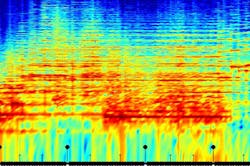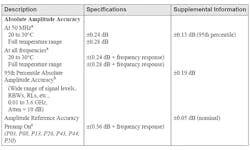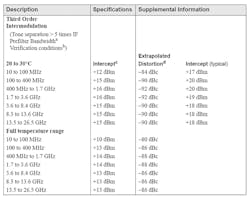Understanding Measurement Uncertainties In Spectrum Analysis
In previous articles, I have provided information on the relationship between measurement speed, repeatability, and dynamic range. In many cases, improving one of these parameters can be at the expense of the other two. An example of this would be performing less averaging which improves speed but has an adverse effect on repeatability and potentially can limit dynamic range. This article will detail the accuracy of measurements and a similar codependence this has with dynamic range, measurement speed, and repeatability.
The Specifications Guide
Any study on spectrum analyzers should begin with a look at published specifications for spectrum analyzers provided by their manufacturers. The Agilent N9020A MXA signal analyzer will serve as an example for this article. The instrument’s Specification Guide can be downloaded here.
It may be surprising that this specifications guide is nearly 400 pages in length. Agilent and other signal analyzer manufacturers spend considerable time deriving these specifications and then testing them in production and during instrument calibration to guarantee the performance of the instrument; should it not meet any of the guaranteed specifications, the instrument needs to be repaired. This adds an extreme amount of value to a test engineer who normally works within a measurement uncertainty, dynamic range, and test time budget and can now analytically determine what signal analyzer price-performance mix will work best in their test system today, as well as when additional signal analyzers may be needed when the production line or lab expands in the future.
Understanding a Specification Guide
The N9020A MXA signal analyzer specification guide is split into three columns. The first column is a description of the specifications as well as the range and parameters for which each specification applies. This can be the temperature range, such as 0 to +55°C in field-deployable applications, or +20 to +30°C for manufacturing or bench top use. The center column displays the guaranteed specifications. These specifications include the measurement uncertainties for the equipment used during production, as well as those used during calibration. Environmental guard bands are also included in these specifications, such as temperature range and humidity. Many users of Agilent test equipment see actual performance levels well beyond the specified performance limits. To address this, a third column provides supplemental information that might be useful to the test engineer. This might be typical performance beyond the specification that 80% of the instruments exhibit with a 95% confidence level over the temperature range +20 to +30°C that a user is most likely to observe. An example of a specification table is provided below.
Dynamic Range
The Specification Guide also provides performance values for various dynamic-range specifications, such as third-order intercept (TOI), phase noise, harmonics, and spurious response. These specifications, when used in conjunction with the accuracy specifications, should be used to determine what test limit is needed to guarantee that the performance of the device under test (DUT) meets the specification given for the DUT. Insufficient dynamic range or accuracy or a combination of these can be the source of DUT yield issues which can have significant implications in the cost of test. This can be the result of false failures in production or, even worse, the shipment of failed devices that supposedly passed.
TOI Example
As an example, the accuracy and dynamic range specifications of an N9020A MXA signal analyzer can be used to determine what test line limit can set for making a TOI measurement of a DUT that has a TOI specification of +22 dBm at a 1-GHz carrier frequency.
It is first necessary to determine an optimum carrier level to test the DUT. A -10 dBm output level from the DUT should produce a TOI product of -64 dBc (at most) below the level of the fundamental frequency amplitudes. This can be found by the following relationship:
TOI = Afund - (1/2)D (1)
or
D = 2(Afund - TOI) (2)
where
Afund is the amplitude of the fundamental frequency tone and D is the difference in amplitude of the fundamental and distortion product in dBc.
Testing the DUT to a limit of -64 dBc, however, would not include the measurement uncertainties that should be included in a pass/fail test limit. These include uncertainties from the TOI dynamic range of the signal analyzer and amplitude uncertainties in a relative amplitude measurement.
The dynamic range of the MXA signal analyzer should also be considered when evaluating its TOI measurement capabilities. The TOI specification is +16 dBm at a fundamental frequency of 1 GHz.
This specification is based upon the mixer level and not the level at the input. The mixer level is given below:
Mixer Level = Fundamental Level - input attenuation - external attenuation
Substituting Afund with mixer level yields:
D = 2(Mixer Level -TOI) (3)
Equation 3 explains that increasing the spectrum analyzer input attenuation improves the signal analyzer’s internal distortion products. As an example, as shown in Equation 4, the internal attenuation can be increased to 16 dB with no external attenuation to calculate the distortion level (in dBc) with a fundamental level of -10 dBm from the DUT:
D = 2(-26 dBm - 16 dBm) = -84 dBc (4)
By knowing the dynamic range of the signal analyzer’s TOI, it is possible to stay with an input level from the DUT of -10 dBm and the instrument’s internal attenuation set to 16 dB will have a 20-dB margin between the DUT distortion products and the signal analyzer’s internally generated distortion products. In a worst-case scenario, the internal and DUT distortion products could sum together in phase to decrease the dynamic range by 20LOG[1 + 10(-20/20)] or 0.83 dB or increase the dynamic range by 20LOG[1 + 10(-20/20)] or -0.46 dB. This uncertainty in the measurement result due to dynamic range would need to be included in the test limit to make for a more stringent test of device performance. However, adding an additional 10-dB attenuation to the 16-dB input attenuation lowers this uncertainty to +0.27 dB/-0.28 dB. This significantly lowers the dynamic range uncertainty portion of the test limit.
When using the narrow spans normally part of TOI measurements, the measurement uncertainty is dominated by the display scale fidelity of the test instrument. Modern spectrum analyzers with all-digital intermediate-frequency (IF) circuitry have extremely good linearity when compared with analog IF circuitry used in the past. The display-scale-fidelity specification is approximately ±0.07 dB.
These worst-case uncertainties can now be added to a DUT specification and be used to set a test limit that ensures that the dynamic range and accuracy of the signal analyzer do not cause yield issues or result in a DUTpassing a production test that should have failed the test. In many cases, additional uncertainties apply that were not used in this example such as environmental uncertainties or measurement uncertainties from other test devices in the system.
Summary
Modern test equipment manufacturers go to great lengths to ensure that the user is given sufficient specifications to determine measurement uncertainties for a particular measurement. These instrument specifications should enable the user to not only know what the uncertainties are, but how to improve upon them in many cases.
About the Author
Bob Nelson
MXA (N9020A) Product Support Engineer
Bob Nelson is Agilent Technologies’ MXA (N9020A) Product Support Engineer. He has spent the last 14 years with the company, supporting the Agilent field organization and customers with application-focused measurement requirements. Nelson holds a degree in Electrical and Electronic Engineering from California State University, Chico.


